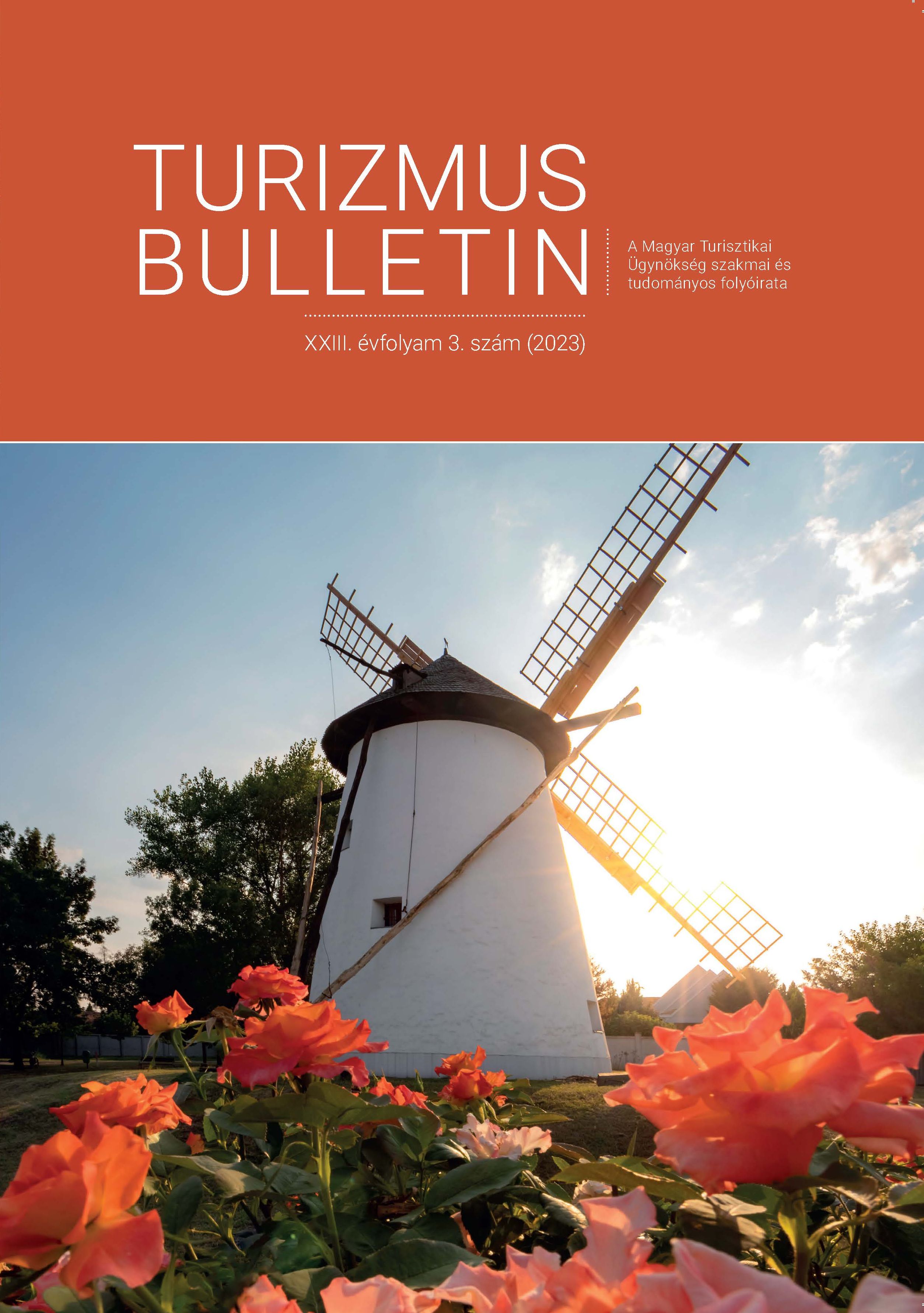Mire figyeljünk közösen tervezett turisztikai termékek kialakításakor? Esettanulmány Budapestről
DOI:
https://doi.org/10.14267/TURBULL.2023v23n3.5Kulcsszavak:
turisztikai társalkotás, city branding, kulturális turizmus, fenntartható turizmusAbsztrakt
Ez a tanulmány a helymárka, a jóllét és az identitás fogalmát vizsgálja a budapesti helymárka kontextusában, továbbá ezen faktoroknak a fenntartható turizmusra gyakorolt közvetlen hatását elemzi. A szerzők a helyi érdekeltek bevonásának fontosságát hangsúlyozzák a valósághű helymárka létrehozásában, és sorra veszik a fővárosi turizmussal kapcsolatos kihívásokat, így a túlturizmust és a kommunikációs hiányosságokat. A szerzők kiemelik Budapest hagyományos fürdőkultúráját, mint a városi turizmus potenciális, közösen létrehozott értékesítési ajánlatát. A helyi fürdőkultúra kultúrális öröksége bemutatásának szándékával közösen létrehozott értékesítési ajánlatot (Co-Created Selling Proposition, CCSP) javasolnak, amelybe bevonnák az üzleti vállalkozásokat, a civil szervezeteket és a turisztikai hatóságokat. A tanulmány arra a következtetésre jut, hogy a turizmus, a jóllét és a kulturális ökoszisztéma szolgáltatásai közti kapcsolatok feltérképezéséhez további kutatásra van szükség.
Hivatkozások
ASHWORTH, A. (2006): Four Threats to the Presumption of Innocence. International Journal of Evidence and Proof. 10(4). pp. 241–278. https:// doi.org/10.1350/ijep.10.4.241
BRAUN, V. – CLARKE, V. (2006): Using thematic analysis in psychology. Qualitative Research in Psychology. 3(2). pp. 77–101. https://doi. org/10.1191/1478088706qp063oa
BRAUN, E. – ESHUIS, J. – KLIJN E. H. – ZENKER, S. (2018): Improving place reputation: Do an open place brand process and an identity-image match pay off? Cities. 80. pp. 22–28. https://doi. org/10.1016/j.cities.2017.06.010
BREGOLI, I. (2012): Effects of DMO Coordination on Destination Brand Identity: A MixedMethod Study on the City of Edinburgh. Journal of Travel Research. 52(2). pp. 212–224. https://doi. org/10.1177/0047287512461566
CAMATTI, N. – WALLINGTON, S. (2022): Cocreation and internal place branding: a case study of Plettenberg Bay, South Africa. Place Branding and Public Diplomacy. https://doi. org/10.1057/s41254-022-00279-x
CAMPELO, A. – AITKEN, R. – THYNE, M. – GNOTH, J. (2014): Sense of Place: The Importance for Destination Branding. Journal of Travel Research. 53(2). pp. 154–166. https://doi. org/10.1177/0047287513496474
CRESWELL, J. W. (2013): Qualitative inquiry and research design. Thousand Oaks, California, USA.
JÁSZBERÉNYI M. – BOROS K. – MISKOLCZI M. (2022): Vonzerőfejlesztés a kulturális és aktív turizmusban. Budapest: Akadémiai Kiadó. https://doi.org/10.1556/9789634548041
KALANDIDES, A. (2011): The problem with spatial identity: revisiting the “sense of place”. Journal of Place Management and Development. 4. pp. 28– 39. https://doi.org/10.1108/17538331111117142
KAVARATZIS, M. (2008): From city marketing to city branding: an interdisciplinary analysis with reference to Amsterdam, Budapest and Athens. Phd thesis. Groningen University, Netherlands.
KAVARATZIS, M. – HATCH, M. J. (2013): The dynamics of place brands: An identitybased approach to place branding theory. Marketing Theory. 13(1). pp. 69–86. https://doi. org/10.1177/1470593112467268
KAVARATZIS, M. – KALANDIDES, A. (2015): Rethinking the place brand: the interactive formation of place brands and the role of participatory place branding. Environment and Planning A: Economy and Space. 47(6). pp. 1368– 1382. https://doi.org/10.1177/0308518X15594918
KIM, E. – CHIANG, L. – TANG, L. (2017): Investigating wellness tourists’ motivation, engagement, and loyalty: in search of the missing link. Journal of Travel & Tourism Marketing. 34(7). pp. 867–879. https://doi.org/1 0.1080/10548408.2016.1261756
KISS K. – MOLNÁR-CSOMÓS I. – KINCSES F. (2021): Buli van? – Mitől lehet vonzó Budapest VII. kerülete a hazai fogyasztók számára? Turizmus Bulletin. 21(4). pp. 43–52. https://doi. org/10.14267/TURBULL.2021v21n4.5
MICHALKÓ, G. – KISS, K. – KOVÁCS, B. – SULYOK, J. (2009): The impact of tourism on subjective quality of life among Hungarian population, Hungarian Geographical Bulletin, 58(2), pp. 121–136.
MILANO, C. – NOVELLI, M. – CHEER, J. M. (2019): Overtourism and degrowth: a social movements perspective. Journal of Sustainable Tourism. 27(12). pp. 1857–1875. https://doi.org/ 10.1080/09669582.2019.1650054
MORGAN, N. – PRITCHARD, A. – PRIDE, R. (2009): Destination Branding, Second Edition: Creating the unique destination proposition. Taylor & Francis, Oxford, UK.
NAMAZ, L. – HORVÁTH, D. – COSOVAN, A. – TVERGYÁK, K. K. (2018): Városmárkahűség: melyek a Budapesti márkahűséget befolyásoló legfőbb tényezők? Turizmus Bulletin. 18(4). pp. 4–14. https://doi.org/10.14267/ TURBULL.2018v18n4.1
NEUHOFER, B. – BUHALIS, D. – LADKIN, A. (2012): Conceptualising technology enhanced destination experiences. Journal of Destination Marketing & Management. 1(1-2). pp. 36–46. https://doi.org/10.1016/j.jdmm.2012.08.001
NTOUNIS, N. – KAVARATZIS, M. (2017): Rebranding the High Street: the place branding process and reflections from three UK towns. Journal of Place Management and Development. 10(4). pp. 392–403. https://doi.org/10.1108/ jpmd-12-2015-0056
PAGE, S. – HARTWELL, H. – JOHNS, N. – FYAL, A. – LADKIN, A. – HEMINGWAY, A. (2017): Case study: Wellness, tourism and small business development in a UK coastal resort: Public engagement in practice. Tourism Management. 60. pp. 466–477. https://doi. org/10.1016/j.tourman.2016.12.014
REITSAMER, B. F. – BRUNNER-SPERDIN, A. (2017): Tourist destination perception and wellbeing: What makes a destination attractive? Journal of Vacation Marketing. 23. pp. 55–72. https://doi.org/10.1177/1356766715615914
SANTANA, A. – MORENO-GIL, S. (2018): Understanding tourism loyalty: Horizontal vs. destination loyalty. Tourism Management. 65. pp. 245–255. https://doi.org/10.1016/j. tourman.2017.10.011
SMITH, M. K. – DIEKMANN, A. (2017): Tourism and wellbeing. Annals of Tourism Research. 66. pp. 1–13. https://doi.org/10.1016/j. annals.2017.05.006
SMITH, M. K. – PUCZKÓ, L. (2013): Health, tourism and hospitality: Spas. Wellness and Medical Travel, London: Routledge.
SMITH, M. K. – PINKE SZIVA, I – OLT, G. (2019): Overtourism and Resident Resistance in Budapest. Tourism planning & Development. 16(4). pp. 376–392. https://doi.org/10.1080/2156 8316.2019.1595705
SOUIDEN, N. – LADHARI, R. – CHIADMI, N. (2017): Destination personality and destination image. Journal of Hospitality and Tourism Management. 32. pp. 54–70. https://doi. org/10.1016/j.jhtm.2017.04.003
UCHINAKA, S. – YOGANATHAN, V. – OSBURG, V. S. (2019): Classifying residents’ roles as online place-ambassadors. Tourism Management. 71. pp. 137–150. https://doi.org/10.1016/j. tourman.2018.10.008
VOIGT, C. – BROWN, G. – HOWAT, G. (2011): Wellness tourists: in search of transformation. Tourism Review. 66(1/2). pp. 16–30. https://doi. org/10.1108/16605371111127206
WEISS, R. – SCHUSTER, S. J. (2005): Learning From Strangers: The Art and Method of Qualitative Interview Studies. The Free Press.
YIN, R. (2009): Case Study research: design and methods. Sage.

